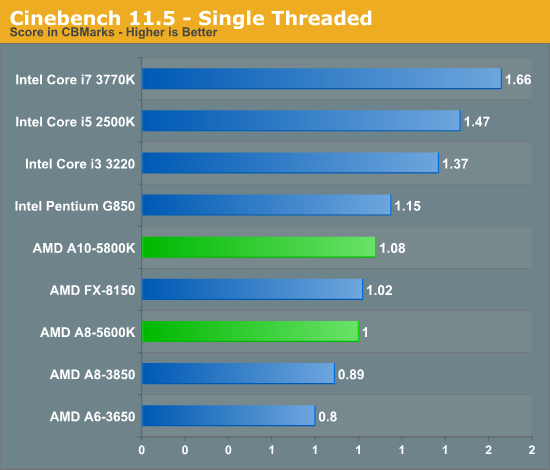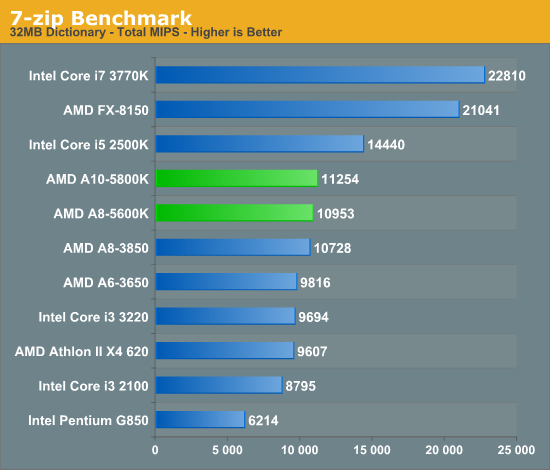AMD A10-5800K & A8-5600K Review: Trinity on the Desktop, Part 2
by Anand Lal Shimpi on October 2, 2012 1:45 AM ESTTrinity CPU Performance: The Good and the Bad
We're going to start our performance investigation a little out of order. The big question on everyone's mind is how much single threaded performance has improved over Bulldozer, and whether it's enough to actually make Trinity faster than Llano across the board. We'll use Cinebench 11.5 as it has both single and multithreaded test options:

The good news is that single threaded performance is definitely up compared to Llano. Piledriver likely has some to do with this, but so does the fact that the A10 can run at up to 4.2GHz (~4GHz typically) with one of its cores active compared to the 2.9GHz clock speed of the A8-3850. Compared to the Bulldozer based FX-8150 there's a slight (~6%) increase in single threaded performance. Although I don't expect anyone will be cross shopping a Trinity APU and a FX CPU, it's important to keep an eye on progress here as we'll eventually get a high-end quad-module/eight-core Piledriver CPU.
Note that compared to even previous generation, low-end Intel CPUs without turbo there's a huge gap in single threaded performance. If we look at the gap AMD has to make up vs. Ivy Bridge it's not pretty. Intel's Core i3 3220 manages a 27% performance advantage over the A10-5800K. Even if Steamroller is able to deliver a 15% increase in performance at the same clock speed, there will still be a gap. And we're not even talking about how Haswell will grow this gap. For the foreseeable future I don't see AMD closing the single threaded performance gap. Jim Keller's job is to fix this problem, but it'll probably take 2 - 3 years to get there.

The multithreaded test shows the other end of reality: in heavily threaded foating point workloads it's possible that we'll see a regression compared to Llano. Remember the Bulldozer/Piledriver architecture prioritizes integer over floating point performance. Truth be told this regression is pretty rare in our tests, but until we get to Steamroller we will still see these types of situations.
Throw more threads at the problem and even with a floating point workload Intel can't pull ahead however. The A10 offers similar performance to the Core i3 3220 at a lower price. Your decision here would come down to the rest of the factors: single threaded performance, processor graphics performance, overclocking capabilities and power consumption. Intel and AMD both win two of those each, it's really a matter of what matters most to you.
A heavily threaded FP workload doesn't really play to AMD's advantages though, what happens when you get a heavily threaded integer workload however? The 7-zip benchmark gives us just that:

Here AMD manages a 16% performance advantage over the Core i3 3220. I'd even go as far as to say that Trinity would likely beat any dual-core Intel machine here. The performance advantage is somewhat artificial as Intel purposefully removes turbo from its dual-core desktop CPUs. This should be AMD's best foot forward, but once again it'll likely take Steamroller for this design to start to make sense.
Speaking of artificial product segmentation, one major feature Intel takes away when you get down to the dual-core desktop i3 level is AES-NI support. Hardware accelerated AES support is something that you get only with the more expensive Core i5/i7s. With Trinity, you get AES-NI support for the entire stack. The result is much better performance in those applications that depend on it:

Like most of the advantages we've talked about thus far, there are really very specific use cases where Trinity makes sense over a similarly priced Intel CPU.










178 Comments
View All Comments
ditroia - Tuesday, October 2, 2012 - link
Hi Does anyone know what the highest end Radeon GPU I can use to Crossfire with the 7 Series GPU on the APU?Thanks in Advance
Dave
Roland00Address - Tuesday, October 2, 2012 - link
Cards you can do crossfire with the integrated graphics are as followsIf you buy itself
6450, 6570, 6670
If you get it prebuilt (these are the same gpus as above but they have a 1000 added to the number for that is what hp, dell, acer convinced amd to do for bigger numbers sell).
7450, 7570, 7670
That said you might want to do your research on asymmetric crossfire before hand, based on other websites reviews that tested it you are only going to get 30 to 60 percent scaling and the 7700 series cards are usually faster than the asymmetric crossfire.
ditroia - Tuesday, October 2, 2012 - link
Disappointing that you can't crossfire with a & series Discrete 7 series GPU, as I think that would have made a cheap but powerful Gaming system.Thanks
mikato - Wednesday, October 3, 2012 - link
Yeah I was really hoping to see a Crossfire with a lower end card as part of this review.Jamahl - Tuesday, October 2, 2012 - link
Llano vs the 2105 last year -http://www.anandtech.com/show/4476/amd-a83850-revi...
"Look at our single-threaded Cinebench scores below and you'll see a 50% performance advantage."
"CPU bound gaming performance is also an area where the A8 falls behind the i3. Here you're looking at a 25 - 50% advantage for the i3-2100/2105"
This is partly due to Ivy Bridge being so underwhelming.
The only problem I see is with load power which has gone backwards.
JKnows - Tuesday, October 2, 2012 - link
Video Drivers: AMD Catalyst 12.3 ???Are you kidding? That driver cannot even use Trinity architecture...
aislanluiz - Tuesday, October 2, 2012 - link
We’re power users, after all. We know how to cope with heat and noise; we can deal with a 100 W chip, even in an HTPC. But there’s no way to make the Core i3 look better unless you spring for an add-in card. AMD’s emphasis on balance makes the A10-5800K a better platform for more people than Intel’s closest competition.frozentundra123456 - Tuesday, October 2, 2012 - link
Trinity may be attractive for HTPC, but I cannot imagine a "power user" who does not have a discrete card in a desktop, at least if you are at all into gaming. The igpus are pathetic for gaming and you get better performance with intel plus discrete card.ericore - Tuesday, October 2, 2012 - link
I don't think Anand has a single benchmark that uses an App from AMD appStore. Even Tom's hardware was considerate enough to use Adobe CS6 products. I'm sorry but this benchmark makes Intel look better than it does. The benchmark is fully Intel optimized, System Max is Intel Optimized, no a single benchmark is AMD optimized. Disappointed Anand.The following review is much more fair:
http://www.tomshardware.com/reviews/a10-5800k-a8-5...
Beenthere - Tuesday, October 2, 2012 - link
The haters won't be happy but it's great that AMD has delivered as promised with Trinity desktop in addition to laptop. Trinity desktop delivers performance and value for those looking for an all-in-one solution at an extremely affordable price - which is a growing segment of the market as people discover the huge cost savings compared to a discrete CPU/GPU set-up. BTW, no one would ever consider Intel 2500 graphics as being usable, so the Trinity desktop APUs are literally in a class of their own for now.It's also worth noting that single thread performance is not the holy grail. Most people running modern software will be perfectly happy with Trinity desktop performance even if you crunch numbers now and then. Price and performance wise AMD has delivered a winning solution when you look at performance vs. cost. This will force Intel to discount it's i3/i5 products, which is good for all.
Obviously Trinity desktop is NOT intended as a replacement for a highend discrete CPU/GPU system. That will come in a few more years but for now AMD continues to offer excellent performance and value, which is what mainstream consumers desire.